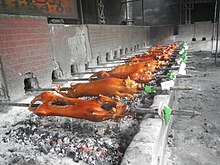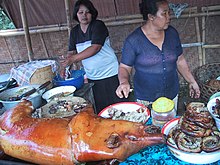
Cajun cuisine is a style of cooking developed by the Cajun–Acadians who were deported from Acadia to Louisiana during the 18th century and who incorporated West African, French and Spanish cooking techniques into their original cuisine.

Barbecue or barbeque is a term used with significant regional and national variations to describe various cooking methods that employ live fire and smoke to cook the food. The term is also generally applied to the devices associated with those methods, the broader cuisines that these methods produce, and the meals or gatherings at which this style of food is cooked and served. The cooking methods associated with barbecuing vary significantly but most involve outdoor cooking.
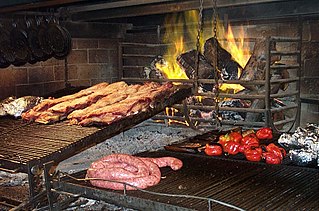
Asado is the technique and the social event of having or attending a barbecue in various South American countries: especially Argentina, Chile, Paraguay, Peru, and Uruguay where it is also a traditional event. An asado usually consists of beef, pork, chicken, chorizo, and morcilla; all of which are cooked using an open fire or a grill, called a parrilla. Usually, red wine and side dishes such as salads accompany the main meats, which are prepared by a designated cook called the asador or parrillero.

Rotisserie, also known as spit-roasting, is a style of roasting where meat is skewered on a spit – a long, solid rod used to hold food while it is being cooked over a fire in a fireplace or over a campfire, or roasted in an oven. This method is generally used for cooking large joints of meat or entire animals, such as pigs or turkeys. The rotation cooks the meat evenly in its own juices and allows easy access for continuous basting.

Churrasco is the Portuguese and Spanish name for grilled beef prominent in the cuisines of Brazil, Colombia, Uruguay, and Argentina. The term is used in other Spanish- and Portuguese-speaking countries for a variety of different meat products.
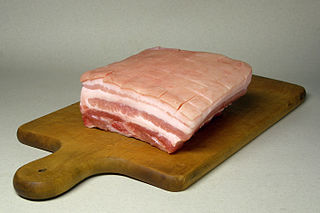
Pork belly or belly pork is a boneless, fatty cut of pork from the belly of a pig. Pork belly is particularly popular in Filipino, Hispanic, Chinese, Danish, Norwegian, Korean, Polish, Thai, and American cuisine.
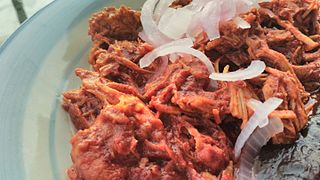
Cochinita pibil is a traditional Yucatec Mayan slow-roasted pork dish from the Yucatán Peninsula. Preparation of traditional cochinita involves marinating the meat in strongly acidic citrus juice, adding annatto seed, which imparts a vivid burnt orange color, and roasting the meat in a píib while it is wrapped in banana leaf.

A pig pickin' is a type of party or gathering held primarily in the American South which involves the barbecuing of a whole hog. Females, or gilts, are used as well. Boars and sows generally are too large.
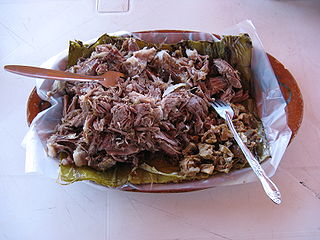
Barbacoa or Asado en Barbacoa in Mexico, refers to the local indigenous variation of the primitive method of cooking in a pit or earth oven. It generally refers to slow-cooking meats or whole sheep, whole cows, whole beef heads, or whole goats in a hole dug in the ground, and covered with agave (maguey) leaves, although the interpretation is loose, and in the present day may refer to meat steamed until tender. This meat is known for its high fat content and strong flavor, often accompanied with onions and cilantro. Because this method of cooking was used throughout different regions by different ethnic groups or tribes in Mexico, each had their own name for it; for the Nahuatl it was called nakakoyonki; for the Mayan it was called píib; for the Otomi it was called thumngö.

Char siu is a Cantonese-style of barbecued pork. Originating in Guangdong, it is eaten with rice, used as an ingredient for noodle dishes or in stir fries, and as a filling for chasiu baau or pineapple buns. Five-spice powder is the primary spice, honey or other sweeteners are used as a glaze, and the characteristic red color comes from the red yeast rice when made traditionally.
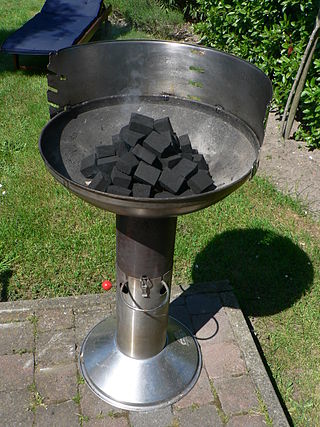
Barbecue varies by the type of meat, sauce, rub, or other flavorings used, the point in barbecuing at which they are added, the role smoke plays, the equipment and fuel used, cooking temperature, and cooking time.

Siu mei is the generic Cantonese name of meats roasted on spits over an open fire or a large wood-burning rotisserie oven. It creates a unique, deep barbecue flavor and the roast is usually coated with a flavorful sauce before roasting. Siu mei is very popular in Hong Kong, Macau, and overseas Chinatowns, especially with Cantonese emigrants. In Hong Kong, the average person eats siu mei once every four days, with char siu being the most popular, followed by siu yuk second, and roast goose third. Some dishes, such as white cut chicken and soy sauce chicken, are not roasted at all but are considered siu mei nonetheless. Siu mei is also known colloquially as siu laap, as the latter term encompasses siu mei and laap mei, a type of preserved meat. They are usually prepared in the same kitchen during autumn and winter season in what are often known as siu laap establishments or Chinese BBQ shops. Siu laap is also often sold alongside lou mei, such as orange cuttlefish and pig's ear.
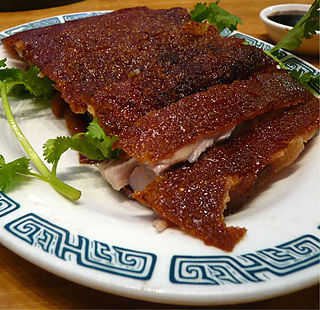
Siu yuk is a variety of siu mei, or roasted meat dishes, in Cantonese cuisine. It is made by roasting an entire pig with seasonings, such as salt and vinegar in a charcoal furnace at high temperature. Roasted pigs of high quality have crisp skin and juicy and tender meat. Usually the meat is served plain with its skin, but it is sometimes served with soy sauce or hoisin sauce.

Inihaw, also known as sinugba or inasal, are various types of grilled or spit-roasted barbecue dishes from the Philippines. They are usually made from pork or chicken and are served on bamboo skewers or in small cubes with a soy sauce and vinegar-based dip. The term can also refer to any meat or seafood dish cooked and served in a similar way. Inihaw are commonly sold as street food and are eaten with white rice or rice cooked in coconut leaves (pusô). Inihaw is also commonly referred to as Filipino barbecue or (informally) Pinoy BBQ.

Paksiw is a Filipino style of cooking, whose name means "to cook and simmer in vinegar". Common dishes bearing the term, however, can vary substantially depending on what is being cooked.
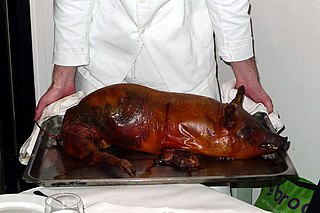
A suckling pig is a piglet fed on its mother's milk. In culinary contexts, a suckling pig is slaughtered between the ages of two and six weeks. It is traditionally cooked whole, often roasted, in various cuisines. It is usually prepared for special occasions and gatherings. The most popular preparation can be found in Spain and Portugal under the name lechón (Spanish) or leitão (Portuguese).

Philippine asado refers to two different Filipino braised meat dishes. The name originates from Spanish asado ("grilled"), a reference to the original dish it was applied to, the Chinese-Filipino version of char siu barbecues usually known as pork asado. However, the Filipino versions have evolved to be braised, not grilled. The other Filipino dishes also known as asado are asado de carajay and asado matua. Unlike the Chinese-derived version, they are savory rather than sweet.

